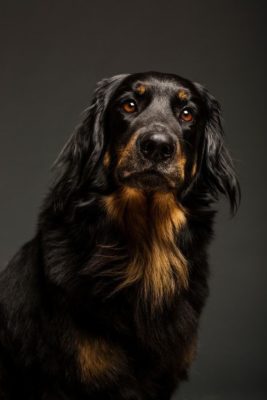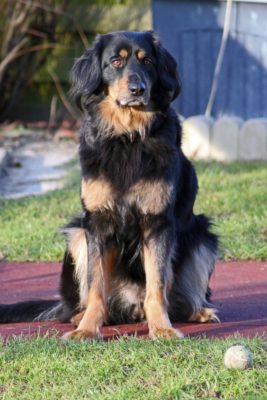Hovawart
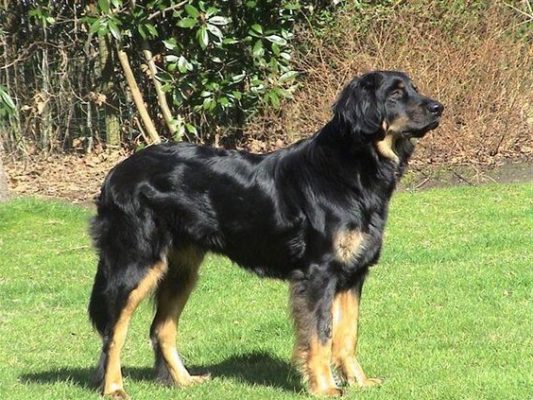
A calm, balanced dog can be a great family friend or home guard. Hovawarts have an excellent sense of smell and well-developed hunting qualities. They can pursue with their owner, spend time fishing or be present for other activities.
Table of Contents
Breed Information
| Another Name | – |
| Origin | Germany |
| Height | Males 63-70 cm Females 58-65 cm |
| Weight | 30-40 kg |
| Fur | Long, slightly wavy |
| Color | Pale, black, black and tan |
| Lifespan | 10-12 years |
| FCI Classification | Pinscher and Schnauzer – Molossoid and Swiss Mountain and Cattledogs |
| Group | Watchdogs, for protection (guard dogs) |
| Price | $1000 |
Breed Photos
Origin History
The Hovawart comes from Germany, where it first appeared in the 13th century. Mentioned in German chronicles, it was soon recognized as one of the noblest dogs in Germany.
In those days, having a Hovawart was very elite and expensive. People marveled at the dog’s independence and courage, and all high-ranking nobles, aristocrats wanted to have this pet.
The Hovawart assisted the owner in hunting large birds, and other animals accompanied him during hikes. The name of the breed means a court, homestead, and guard. When the aristocracy lost interest in the breed, its numbers declined dramatically. Over the centuries, the breed was hardly ever mentioned.
In the early twentieth century, scientists (father and son, Bertram and Kurt Koenig) began to pay more attention to the Hovawart, which contributed to the breed’s formation as it is today. The breed was officially recognized in 1964, and the Hovawart Federation was formed in 1983.
Appearance
The Hovawart is of medium size, with a strong body and a slightly elongated format. The dog has a long tail, which is not cropped. The ears are naturally down, not cut.
The hair of the dog is thick, long, slightly wavy; there is a small undercoat. Color can be black, black and tan, pale. There may be some white hair at the tip of the tail and on the chest. The head and forelegs have shorter hair than the body.
Males are about 63-70 cm tall, and females are about 58-65 cm tall. The weight is usually 30 to 40 kg. The Hovawart has a broad chest, which makes the body healthy and sturdy. The eyes are small, and the color is light to dark brown.
Character
A calm, balanced dog can be a great family friend or home guard. Hovawarts have an excellent sense of smell and well-developed hunting qualities. They can pursue with their owner, spend time fishing or be present for other activities.
The Hovawart has search and rescue skills, a balanced psyche, and a high level of intelligence. It is one of the most versatile dog breeds that can be used for all walks of life.
It is important to remember that Hovawarts mature quite late. For two or three years, they can remain children and require a lot of play and attention.
He treats other animals in the house relatively well but will always want to dominate them. Hovawarts are often used to help people with disabilities because they love their owner and are willing to protect him at all costs.
Care
Hovawart can live in an apartment, but you must consider that he needs long and active walks in the fresh air. Do not keep the dog on a chain or leash; if you have a country house, it is better to equip an aviary or keep it in the yard.
Hair combing once a week and bathing when dirty is sufficient. In winter, it is recommended to trim the down between the toes. Once a week, it is essential to check ears, eyes, and teeth and clean them gently if soiled. Hovawarts love to swim, and in the summertime, water procedures can be done in the pool or elsewhere.
Training
Bitches usually learn faster than males. They are more cunning and quicker to react to what is going on around them.
But in general, a Hovawart has good training skills. From an early age, you should teach him simple commands (“sit”, “to me”), but from 8-9 months, you can approach training more seriously.
Dogs are brilliant and just show them a few times that you can’t run after cats or pick up food from the street, and they’ll have no problem remembering that.
Common Diseases
Hovawart has good health, good stamina for all conditions. Genetic diseases are almost non-existent; they easily tolerate both hot and cold weather.
But joint diseases can be observed, so during the puppy’s active growth, it is important to monitor the level of exertion. It is vital to have timely vaccinations against parasites, distemper, and rabies.
Nutrition
It is recommended to feed naturally balanced food; most of the diet should consist of meat, vegetables, fruits. Useful supplements such as fish oil, various vitamins, and minerals can be given.
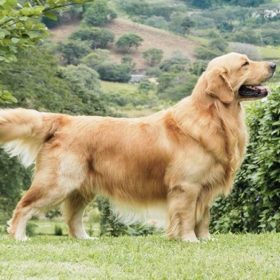 Golden Retriever
Golden Retriever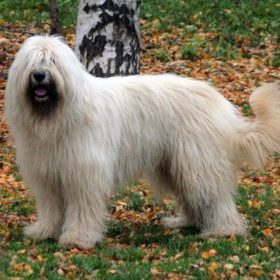 South Russian Ovcharka
South Russian Ovcharka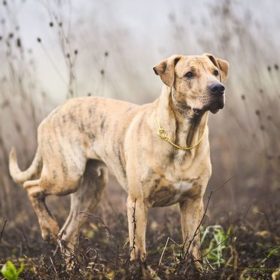 Cimarrón Uruguayo
Cimarrón Uruguayo Dandie Dinmont Terrier
Dandie Dinmont Terrier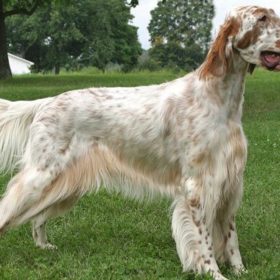 English Setter
English Setter Saluki
Saluki